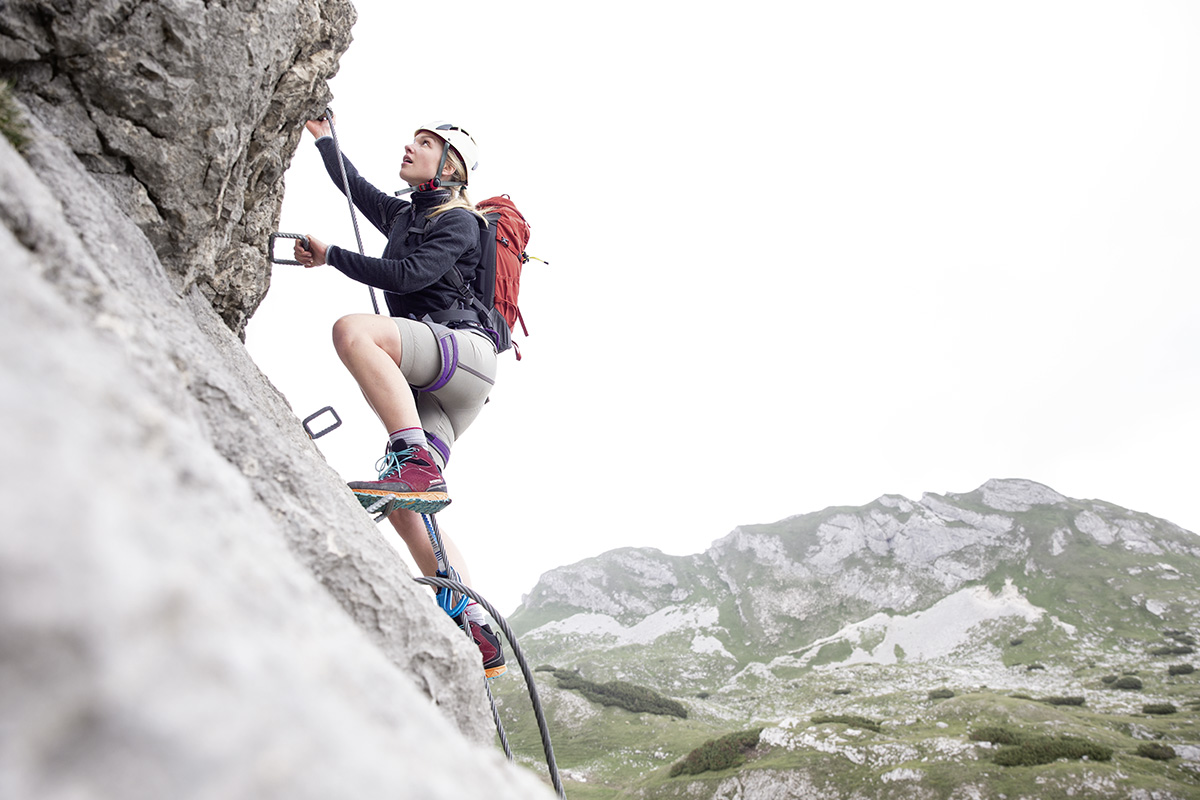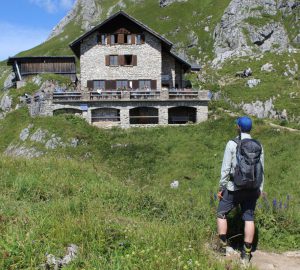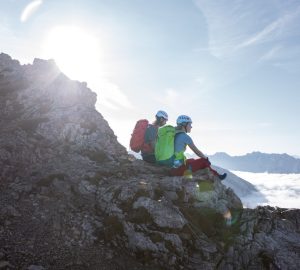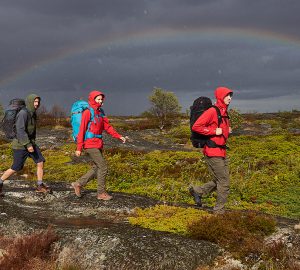Climbing gardens, adventure trails, theme walks, flying fox and via ferrata – many people like summer in the mountains better than winter. More and more mountaineering fans are discovering the via ferrata in particular. Via ferrata can be both – a challenge or a comfortable way of mountaineering with fascinating views (into a yawing abyss).
Via ferrata plays with the extremes: Exposed passages lead past a 200-metre-deep abyss. A long ladder takes you to the next plateau and then you need to climb the overhanging ledge with a pull-up. Your carefully clipped-in via ferrata set and your surefootedness provide the necessary confidence for difficult passages. The feeling of happiness after each mastered section and even more at the summit is as unforgettable as the view over the surrounding mountains and valleys.
Via ferrata: Comfortable, challenging or highly technical
In the Alps you will find the right route for every occasion. The possibilities range from simple tours, which are only slightly more demanding than a hiking trail, to secured and difficult climbs, which are quite close to alpine climbing. For all tours apply: Safety is of the utmost importance. This also includes not overestimating one’s own strengths and carefully selecting the routes.
Via ferrata and the weather
Bad weather can not only make the tour considerably more difficult – it can be life-threatening. Please check the weather forecast carefully before starting. Thunderstorms are the absolute worst case on a via ferrata.
You are exposed to the weather unprotected and the iron rope attracts the lightning bolts like a lightning rod. The equipment is also metallic and the rain makes everything slippery. This is not a situation you want to be in.
If lightning strikes are imminent, you should leave the via ferrata as soon as possible. If this is not possible and you don’t get away fast enough, a squatting position can offer some protection. Squat with as little ground contact as possible to avoid step voltage. If the terrain permits, unhook the karabiner from the steel cable. Deposit all metal objects far away from you and make an emergency call.
Recommended reading: Basic knowledge of via ferrata for beginners – Tips for a safe via ferrata tour
Professional equipment is compulsory
The most important items of your equipment are a climbing harness and a via ferrata set. They’ll save you from a deep fall. What does a suitable via ferrata set look like? Elastic arms, shock absorbers, easy to operate karabiners and sufficient reach of the arms are the distinguishing features of a good via ferrata set.

Falling on a via ferrata is dangerous despite being secured. The distances between the securing points are sometimes several meters long. This means that a person falls down to the next securing point without braking and only then does the via ferrata set absorb the fall. Due to the construction design, via ferrata sets save you from the total crash, but a controlled fall is not possible.
A typical accident is that the falling person hits the rocks several times until they fall very hard into the last securing point. Avoid falling on a via ferrata!
A comfortable and light helmet protects you from the small stones that a careless climber sets off above you. Special gloves prevent slipping or injuries. Sometimes small wires have come loose of the rope and painfully cut into your palms.
For via ferrata tours, backpacks that are close to the body, compact and do not restrict the movements are most suitable. They should be light and robust at the same time. In case of an emergency, bring a first aid kit and a bivouac bag with you on longer tours. Here you can refresh your basic knowledge about first aid measures.
Via ferrata in the Alps: then and now
Unlike today, the via ferrata did not serve as an intense outdoor experience in history: During the First World War, the Dolomites were a battlefield. The via ferrata were designed to secure the heavily packed Italian and Austrian soldiers from falling and to attack the enemies. Around fifty of these historic routes in South Tyrol are still accessible today.
Only in the last few decades did the via ferrata experience a tentative new beginning, which then led to a real boom. An unbelievable number of fixed rope routes have been newly and spectacularly built. Today there are more than 1,500 vie ferrate in the Alps. And there is no end in sight. We wish you a lot of fun on your tours!
Also interesting: The 3 most amazing vie ferrate around Lake Garda – Sunny vie ferrate around Lake Garda for lovely autumn days
Please note: This article has been published in October 2012 and revised in February 2018.







